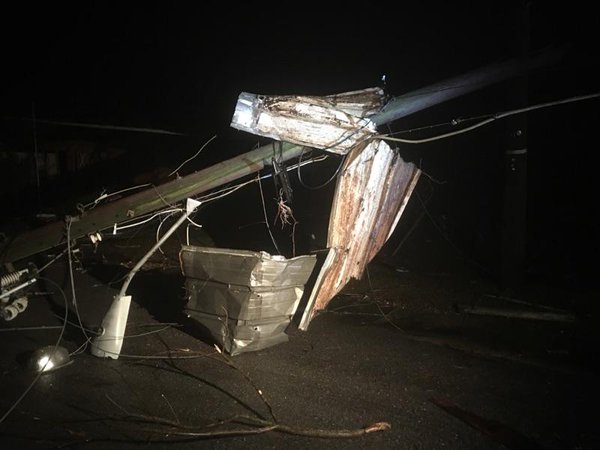From the Escambia County Community and Media Relations Department:
Essential Information
• Escambia County is working with the Town of Century and various agencies today to complete damage assessments and remove downed trees.
• Search and Rescue was completed Monday evening, however teams rechecked homes this morning in the daylight
Damage Assessments
• An estimated 40-50 residences/business were affected by the storm
• Governmental and not-for-profit agencies are working to complete damage assessments
– The National Weather Service out of Mobile has a crew en route to survey damage starting in the McDavid/Century area. They will post updates throughout the day @NWSMobile
Road Closures
• Pond at Highway 29, Hecker at Highway 29, Salters Lake at Highway 29, Front at Highway 29, Bradley at Highway 29, Alger at Highway 29; Freedom, Jefferson, Ramar
First Responders
• Early estimates are that there were 120 first responders on scene Monday night
Debris Pickup
• Special debris pickup has not been determined yet but will be addressed in the immediate future
Shelter Information
• The shelter at Northview High School is closed. There were two residents at the shelter last night
• The Century Community Center (6001-A Industrial Boulevard) is now open and the Red Cross is on scene for assistance
Red Cross
• Meals being delivered
• Clean-up kits/comfort kits will be available soon
• A family service team is being assembled
Other Escambia County Issues
• 9 Mile and Jernigan Road – Currently working a gas leak; once that is repaired power lines and signal will be restored
• Creighton and Spanish Trail – power out, signals out
• Creighton and Scenic – area still closed, city cannot access to evaluate
• Creighton and 9th – power out, signal out
Electrical Issues
• If electrical circuits and electrical equipment have gotten wet or are in or near water, turn off the power at the main breaker or fuse on the service panel. If you must enter standing water to access the main power switch, then call an electrician to turn it off.
• Never turn power on or off or use an electric tool or appliance while standing in water.
• Do not connect generators to your home’s electrical circuits without the approved, automatic-interrupt devices. If a generator is on line when electrical service is restored, it can become a major fire hazard and it may endanger line workers helping to restore power in your area.
Reentering Buildings
• Stay away from damaged buildings or structures until they have been examined and certified as safe by a building inspector or other government authority. You may want to wait to return to buildings during daylight hours, when it is easier to avoid hazards, particularly if the electricity is off and you have no lights.
• Leave immediately if you hear shifting or unusual noises that signal that the structure may fall or if you smell gas or suspect a leak. If you smell gas, notify emergency authorities and do not turn on the lights, light matches, smoke, or do anything that could cause a spark. Do not return to the house until you are told it is safe to do so.
• Keep children and pets out of the affected area until cleanup has been completed.
Chain saw safety:
Each year, approximately 36,000 people are treated in hospital emergency departments for injuries from using chain saws. The potential risk of injury increases after hurricanes and other natural disasters, when chain saws are widely used to remove fallen or partially fallen trees and tree branches.
Safeguards against injury while using a chain saw:
• Operate, adjust and maintain the saw according to manufacturer’s instructions provided in the manual
• Choose the proper size of chain saw to match the job and include safety features such as a chain brake, front and rear hand guards, stop switch, chain catcher and a spark arrester.
• Wear the appropriate protective equipment, including hard hat, safety glasses, hearing protection, heavy work gloves, cut-resistant leg wear (chain saw chaps) that extend from the waist to the top of the foot and boots that cover the ankle.
• Always cut at waist level or below to ensure that you maintain secure control over the chain saw.
• Bystanders or coworkers should remain at least two tree lengths (at least 150 feet) away from anyone felling a tree and at least 30 feet from anyone operating a chain saw to remove limbs or cut a fallen tree
• If injury occurs, apply direct pressure over site(s) of heavy bleeding and call for help. This act may save a life.
Beware of injury from the release of bent trees or branches.
Take extra care in cutting “spring poles†trees or branches that have gotten bent, twisted, hung up on, or caught under another object during a high wind. If the tree or the branch is suddenly released, it may strike the person cutting it, or a bystander, with enough force to cause serious injury or death. Even a seemingly small tree or branch (2 inches in diameter, for example) may pose a hazard when it is released from tension.
To avoid injury:
• Identify the maximum point of tension on the spring pole
• Slowly “shave†the underside of the tree – rather than cut through – to allow the tree or branch to release tension slowly
